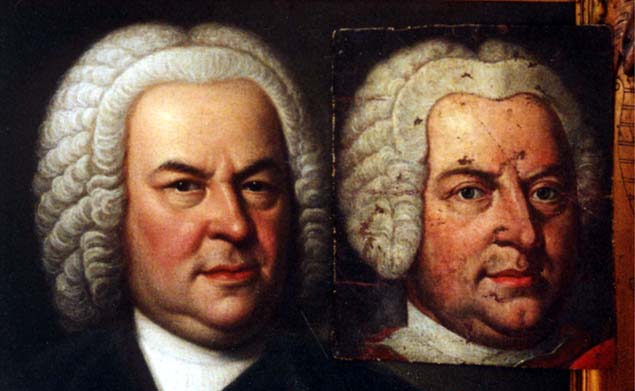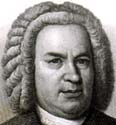The Present Day Misconceptions About Bach Performance Practice in the 19th Century - The Evidence of the Recordings Pages at the Teri Noel
Towe Home Pages - Page 5 - Why An Understanding of What Nineteenth Century Bach Performance Practice Actually Was Is Important at the
Beginning of the Twenty-First Century
Johann Sebastian Bach
Present Day Misconceptions
About Bach Performance Practice in the Nineteenth Century
The Evidence of the Recordings
This remarkable photograph is not a computer generated composite; the original of the Weydenhammer Portrait Fragment, all that
remains of the portrait of Johann Sebastian Bach that belonged to his pupil Johann Christian Kittel, is resting gently on the surface
of the original of the 1748 Elias Gottlob Haussmann Portrait of Johann Sebastian Bach.

1748 Elias Gottlob Haussmann Portrait, Courtesy of William H. Scheide, Princeton, New Jersey
Weydenhammer Portrait Fragment, ca. 1733, Artist Unknown, Courtesy of the Weydenhammer Descendants
Photograph by Teri Noel Towe
©Teri Noel Towe, 2001, All Rights Reserved
PRESENT DAY MISCONCEPTIONS
ABOUT BACH PERFORMANCE PRACTICE IN THE NINETEENTH CENTURY
THE EVIDENCE OF THE RECORDINGS
Page 5
Why An Understanding of What Nineteenth Century Bach Performance Practice Actually Was
Is A Matter of Crucial Importance at the Beginning of the Twenty-First Century
First of all, it is often forgotten how profound an influence early music in general, and Bach in particular, had on many great
19th-century composers. To use Brahms as a paradigm, he was a subscriber to the Bach-Gesellschaft edition, wrote cadenzas for
the Clavier Concerto No. 1 in D Minor, BWV 1052, and conducted public performances of Bach cantatas on numerous
occasions. And it is a fact that he knew the chromatic, descending ostinato theme that is the basis of the last movement of the
Symphony No. 4 in E Minor, Op. 98, from the Bach Cantata, Nach dir, Herr, verlanget mich, BWV 150, before he used it in the
symphony. [23] How can we accurately understand how Bach influenced Brahms unless we have an accurate idea of how he heard
Bach and how he performed Bach? How else can we accurately assess the influence that the Actus Tragicus, BWV 106, had on the
Deutsches Requiem?
David Hamilton recently put it another way in his review of a then new recording of Igor Stravinsky's The Rake's Progress in the
October, 1985, issue of Opus. In discussing the interpretation of that consciously neo-Baroque work, Mr. Hamilton observed:
"Stravinsky's conception of his models is, naturally, conditioned by the performance practice of the thirties and forties,
as embodied in, for example, the Glyndebourne recordings [of Mozart operas]; an interesting topic for speculation is
the future of such style-referential music when the sound of the music to which it refers has changed, as the sound of
eighteenth-century music surely is now in the process of being changed." [24]
Secondly, these recordings and an accurate assessment of the mid-19th-century Bach performance style as it is reflected and
preserved in them may well be an invaluable adjunct to written sources in reconstructing the performance style of still earlier
periods, conceivably even Bach's own. In a fascinating and disconcerting article, "The Recordings of Sir Edward Elgar --
Authenticity and Performance Practice", in the November, 1984, issue of Early Music -- an article that should be carefully
considered by all who are interested in the reconstruction of the performance practice of earlier periods -- Robert Philip wrote:
"One of the reasons that reconstruction of earlier playing styles is so difficult is precisely the fact that we start from the
viewpoint of late 20th- century taste and habits, and use them as the basis for comparison. But what does modern taste
consist of? If the style of Elgar's day is 'old-fashioned', in what ways is modern style 'new-fangled'? The answer...is
that we use more vibrato and less portamento than was used earlier in the century, we are more concerned with clarity
of detail and exact note values, we take most music more slowly and we change tempo less frequently and to a lesser
degree.
If these characteristics of modern style have arisen so recently, do we not have to be very cautious in using them as a
basis for investigating much earlier playing styles? What would happen if, in order to reconstruct, say, the performance
practice of Beethoven's day, we were to start not from modern style but from the style preserved on early gramophone
records?
. . . . our conjectures would be quite different if we were living in the 1920s instead of the 1980s. Similarly 18th- and
19th-century descriptions of tempo rubato make a very different sort of sense if we take early, rather than late,
20th-century style as the starting point for comparison. My own very strong suspicion is that many of the habits
preserved in early gramophone records had their origins at least as far back as Beethoven, and in some cases earlier.
This is something to argue about, but one central point is indisputable: the styles of the early 20th century did not arise
overnight. For this reason, if for no other, it is time for historically minded performers to start considering the
implications of early gramophone records." [25]
Alas, because of inherent weaknesses in early recording technology and the relative lack of interest in the music of Sebastian Bach
that early recording manufacturers perhaps inaccurately perceived in the record buying public of the time, early recordings of the
music of Sebastian Bach, especially of the orchestral and concerted vocal works, are few and far between, and most of those that
were made are exceedingly rare today. Most of these rarities, furthermore, are known only to a handful of obsessed collectors like
myself, who were inoculated at an early age with a 78 RPM stylus. To make matters yet worse, few of the collectors who possess
these discs are at all aware of their inestimable value as research tools to scholars and authenticity-minded performers. The urgency
of the matter seems particularly crucial today because the crusaders for the cause of Uraufführungspraxis have overrun the citadel
of the Romantic Era, barely an instant after our last direct links to that very performance practice, whether for Bach and Handel,
Mozart and Beethoven, Mendelssohn-Bartholdy and Schumann, or Brahms, Liszt, and Wagner have crossed to the next world.
We must treasure the early records and learn from them with open minds and open ears because they are the surrogates, however
fragile, for the artists who best remembered and preserved the performing traditions that they had learned from their predecessors.
Teri Noel Towe
June 24, 2001
Copyright 1985, 1986, 1988, 1989, 2001
Please click on  to return to the Preface.
to return to the Preface.
Click on  to return to the Johann Sebastian Bach Index Page.
to return to the Johann Sebastian Bach Index Page.
Click on the  to return to the Teri Noel Towe Welcome Page.
to return to the Teri Noel Towe Welcome Page.
teritowe@alumni.Princeton.EDU
Copyright, Teri Noel Towe, 1985, 1986, 1988, 1989, 2001
All Rights Reserved
The Present Day Misconceptions About Bach Performance Practice in the Nineteenth Century - The Evidence of the Recordings
Pages at the Teri Noel Towe Home Pages
are PPP Free web pages.

The Present Day Misconceptions About Bach Performance Practice in the Nineteenth Century - The Evidence of the Recordings
Pages at the Teri Noel Towe Home Pages have received
the HIP Woolly Mammoth Stamp of Approval from The HIP-ocrisy Home Page.